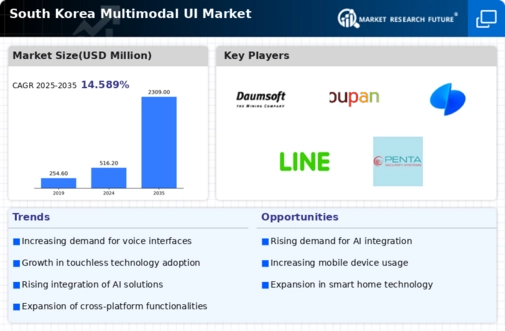Rise of Smart Devices and IoT Integration
The proliferation of smart devices and the Internet of Things (IoT) is a key driver for the multimodal ui market in South Korea. As households and businesses increasingly adopt smart technologies, the demand for interfaces that can seamlessly integrate multiple modes of interaction rises. This trend is evidenced by a reported 30% increase in smart device usage over the past two years. The multimodal ui market is adapting to this shift by developing solutions that facilitate interaction across various devices, enhancing user convenience and functionality. This integration not only streamlines user experiences but also fosters a more interconnected digital ecosystem.
Advancements in Natural Language Processing
Natural Language Processing (NLP) technologies are evolving rapidly, significantly impacting the multimodal ui market. In South Korea, the integration of sophisticated NLP capabilities allows for more effective voice recognition and interaction, enhancing user engagement. As businesses increasingly adopt these technologies, the market is expected to witness substantial growth, with estimates suggesting a potential increase in market size by over $500 million by 2027. This advancement not only improves the functionality of applications but also broadens their accessibility, making them more appealing to a diverse user base. The multimodal ui market is thus positioned to leverage these advancements to create more responsive and intelligent interfaces.
Growing Demand for Enhanced User Experience
The increasing expectation for seamless and intuitive user experiences drives the multimodal ui market in South Korea. As consumers become more accustomed to advanced technologies, they seek interfaces that integrate various modes of interaction, such as touch, voice, and gesture. This demand is reflected in the market, which is projected to grow at a CAGR of approximately 15% over the next five years. Companies are investing in research and development to create more engaging and user-friendly applications, thereby enhancing customer satisfaction. The multimodal ui market is responding to this trend by prioritizing user-centric design principles, which are essential for retaining competitive advantage in a rapidly evolving digital landscape.
Increased Focus on Data Privacy and Security
As the multimodal ui market expands, concerns regarding data privacy and security are becoming increasingly prominent. In South Korea, consumers are becoming more aware of the implications of data usage, prompting companies to prioritize secure and transparent practices. This shift is reflected in the market, where businesses are investing in robust security measures to protect user data. The multimodal ui market is responding by developing interfaces that not only enhance user experience but also ensure compliance with stringent data protection regulations. This focus on security is likely to foster consumer trust and drive market growth in the long term.
Government Initiatives Supporting Digital Transformation
The South Korean government is actively promoting digital transformation across various sectors, which significantly influences the multimodal ui market. Initiatives aimed at enhancing technological infrastructure and fostering innovation are likely to create a conducive environment for market growth. For instance, government funding for tech startups has increased by 25% in the last year, encouraging the development of advanced multimodal interfaces. This support is crucial for the multimodal ui market, as it enables companies to invest in cutting-edge technologies and improve their offerings, ultimately benefiting consumers and businesses alike.
















Leave a Comment